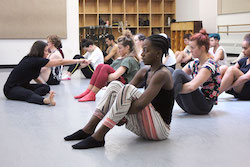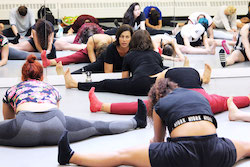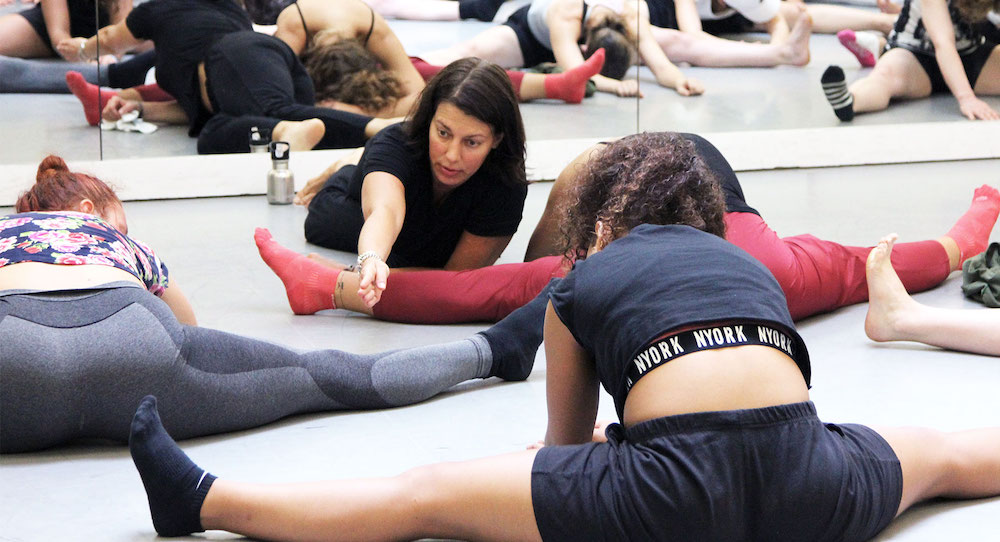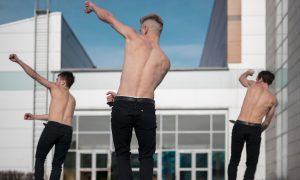As the cold season sets in, being conscious of how you stretch is even more important than usual. Wearing warmups and leaning over a leg on the barre just won’t cut it. Worst case, it could invite injury. If you’re serious about stretching, Lastics stretch technique founder Donna Flagg is here to help.
If personal testimonies from Fosse dancers, orthopedic doctors, the Artistic Director of Joffrey Academy of Dance in Chicago and an NBA athlete aren’t enough to convince you of the power of Lastics, this might:
I dance for a tour bus company in New York City (confused? Catch up on that here), and perform a ballet pas de deux six to 12 times a shift outdoors and on concrete, often in snow storms. By all accounts, my body should be a mess. But when I take the time to go to a Lastics class before my performances, my body feels stretched, strong, stacked and stable. Being that aligned feels a little like magic, but Flagg sat down with me to explain how it works.

What is it about Lastics that’s different from other stretch techniques?
“Other stretches just put your body in place, and assume that a stretch is going to happen. Holding your foot to your glute is still just a position. There’s a sense of movement in Lastics. We also work from the inside-out. We move deep within, tiny little moves, to catch the ends of the muscles. Most stretch techniques don’t use these incremental micro-moves. There’s so much stuff deep in the joints, and moving from the outside is not enough. You have to do something to stretch the muscle, the same way you have to do something to build muscle.”
Where did Lastics start? What made you want to codify it?
“It was kind of an accident. Two things happened at the same time. First, I was healing from a major knee surgery, which made me analyze all of my dance training. My surgeon said that my quads were so strong, and my inner thighs and other muscles that held my knee medially were completely shot. Dancers have strong thighs and hip flexors, and we stretch our inner thighs and hamstrings like crazy. It’s so imbalanced. That was a real eye opener for me.
The second thing was I started training a guy who played for the NBA. They have the best trainers in the world, I thought. I was like, ‘Why do you need me?’ And he said he’d never felt anything like it. He jumped higher, and he ran faster. So if it did that for him (and his body’s like a machine), then I knew I was on to something.”
I was a rhythmic gymnast growing up, and learned a lot of bad stretching habits. What are some of the biggest misconceptions you see?
“Oh gosh. Okay. So dancers throw their body around. That lack of control was really surprising for me. You’re a dancer, you can control every muscle in your body, why are you throwing it around? Another thing is this perception of needing to go farther. And then they go farther and totally lose the form, and the underlying technique.”
There’s a lot of facing your ego in Lastics.
“Totally. I can see dancers look around the room while we’re stretching forward in straddle, like, ‘Oh, everyone’s going to see that I can put my face to the floor.’ They’re not controlling their body, they’re not protecting their knees, they’re not using their turnout muscles. It’s ego, it’s not paying attention to what’s right for your body because you need to show off. Or it’s just not being careful and feeling what you’re doing. The idea is to find your limit. If you’re throwing yourself into the stretches, you’re either going to push right past it and injure yourself, or you’re going to get there the wrong way and build bad habits, which can lead to injury later on.”
What do you find are some of the other benefits of Lastics, besides increased flexibility?
“When I started the technique, I felt like I had seen so many wickedly talented dancers whose lack of flexibility and lack of lines were going to get in their way. I initially thought that I could help those dancers and get them stretched because the method was so effective. But what I ended up having was a bunch of really flexible people come in. I thought, ‘Oh my, I don’t want to stretch you more!‘ I was injured because I was overstretched. It turned out that I teach the tight dancers exactly the opposite of what I teach the loose ones. So for a whole population of dancers, it’s actually about alignment and control, and not flexibility. Most dancers are usually super flexible in one area, and when that happens, they’re super tight somewhere else. It’s balance. If something’s tight, I work on stretching it, and if something’s loose, I work on stabilizing it.”

At the end of each class, you say the same phrase. I love the imagery, and it always helped me take stock of how different my body felt after class. Could you remind me of the exact phrase, and why do you repeat it?
“I repeat it because dancers use their muscles so differently and to such extremes. There’s something in you that’s constantly on; if you turn something else on, it can help it turn off. Firing opposing muscles helps balance energy.
‘Imagine your muscles are in your body like we just combed them out with conditioner, leaving no knots and no kinks, with the bones stacked under the muscles in perfect alignment, and the muscles wrapping around the bones to protect and support them.'”
Want to give Lastics a go, but don’t have access to a live class? Check out the Lastics website to stream classes, and pick up a paperback deep-dive into how to stretch smart. All holiday must-haves, and the perfect gift for any dancer.
By Holly LaRoche of Dance Informa.













